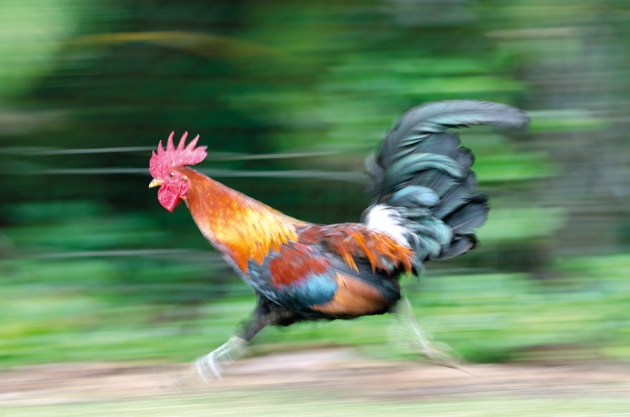“We have come to grips with how we will inspect for market
quality and how the flock matches the standard,” said Dave Anderson, APA
president.
Not every chicken with a Standard name will make a good,
productive flock. Hatchery stock may have unacceptable defects. Birds bred for
exhibition may have lost their productivity. Chickens are more than pretty
feathers.
“They need to have good muscle development, fertility, and
egg production,” said Frank Reese, owner of Good Shepherd Poultry Ranch in
Kansas. “This program should help people improve quality and production of
these birds.”
In the past, the APA inspected flocks, but abandoned that
responsibility 50 years ago. Commercial poultry farms overwhelmed smaller
Standard breed flocks after World War II. The chicken meat business turned to
genetically similar industrially developed chickens, which are unable to mate
and reproduce naturally. They grow to market size in six to seven weeks. If
allowed to grow to maturity, they are hardly able even to walk. Their
underdeveloped immune systems can’t protect them against even ordinary
diseases.
Modern hybrids with flashy names such as Freedom Ranger and
Golden Nugget have been developed to take advantage of the market for chickens
that are raised in better conditions. They may be raised on pasture and fed an
organic diet, but their genetics doom them. They may have unseen internal
abnormalities such as cardiac and skeletal problems.
"Chickens have several serious welfare problems that
come from bad genetics and can be fixed only with good genetics," animal
welfare advisor Temple Grandin wrote in her book, Animals Make Us Human.
Standard breeds have recognizable identity and documented
history. Reviving the inspection program in the 21st century will
help standard breed producers justify the higher prices their products deserve.
The APA Standard of Perfection lists all the breeds that
have been described and officially recognized for exhibition at poultry shows.
That’s about 50 different breeds in hundreds of varieties. The first Standard
was published in 1874. Dates are given for every recognized breed.
That original Standard was written to improve the quality,
uniformity and marketability of poultry flocks. Over the years, its emphasis
changed to focus on poultry exhibitions. Utility became an afterthought,
although the Standard still lists Economic Qualities in its breed descriptions.
‘Standard’ is the operant word, meaning breeds that have
been documented and officially recognized. Heritage, historic, traditional,
antique, heirloom and other words are descriptive, but their meanings vary
slightly and can be stretched and distorted to cover anything. ‘Standard’ is a
word with a defined meaning: If the breed wasn’t in the Standard before 1950, it
can’t get the certification.
APA qualified judges will inspect flocks for their adherence
to the APA written Standard.
“The birds must have the general conformation of their
breed,” said Mr. Anderson. “The flock cannot have more than two percent significant
disqualifications such as roach back. The flock has to have less than 15
percent minor variations from the standard, such as the wrong eye color or side
sprigs on the comb. Of course, the entire flock has to be healthy.”
Judge-inspectors can offer advice to help the producer
improve his flock. They can help the farmer pick out the best birds for
breeding. Their knowledge, and that of the Standard breed producers they
inspect, will help USDA inspectors learn how to grade Standard-bred birds.
“They are not just coming to judge your birds,” said Mr. Reese.
“They are coming to help you. It should be a learning experience.”
Mr. Reese is the leading Standard breed poultry producer in
the country. He currently supplies Emmer & Co. with up to 2,000 chickens
every three weeks and Heritage Foods USA with 500 every three weeks. He raises
Barred Rock and New Hampshire chickens, Bronze and Narragansett turkeys, and
other poultry.
Mr. Reese, in cooperation with the Livestock Conservancy and
others, has developed a Heritage Breed definition that relies on the APA
Standard. His label has been approved by the USDA and goes on each bird
packaged and sold. Thus far, he is the only producer whose label has USDA
approval.
“The APA will offer a stamp like the USDA to help consumers
make their choices,” Mr. Anderson said.
Certification assures the purchaser that the product they
are buying meets certain standards. The USDA’s Certified Organic label is the
best known. Certifications increase product value. The Certified Organic label
has been so successful in increasing the return to producers that major
retailers claim it, not always honestly. Fraud and lack of clarity as to
standards have resulted in some erosion of its value, but it remains a
significant contributor to farm income and consumer trust. Labels are so
important to consumers and influential on the prices they are willing to pay
that in some areas, such as fish, fraudulently mislabeling is common.
Emmer & Co. can’t keep up with the demand. Reese is
raising as many birds as he can for them and works with other producers to
increase the supply.
“These are true, authentic Standard bred chickens,” Reese
said. “If you will breed them to meet the standards, you will have a marketable
animal,”



















